

National Foundation of Swallowing Disorders - A community for those suffering from dysphagia and swallowing related illnesses. By: Elizabeth Lipton, CCC-SLP Picture this: It’s your first day as a clinical fellow in the Speech Pathology department.

You look up the information on your first patient; 55 year-old male with base of tongue cancer experiencing difficulty swallowing 4 weeks into his radiation treatment. You review his swallow study results and consider the best plans for swallowing treatment. Your pager beeps. Hands sweating, you walk to the waiting room to call the patient back. Confidently, you introduce yourself and ask the patient to share the reason for this visit. A wave of relief hits as the patient pulls a cell phone from his shirt pocket, giving you time to unclench every muscle in your body and decide how to introduce the treatment plan. After two minutes (which feels like twenty), the patient hangs up, sets his phone to “vibrate only” mode, briefly apologizes, and we get on with the session. Speech news right to you! If you do anything long enough, it stands to reason that you may experience burn out.
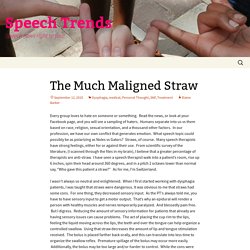
After 20 plus years in skilled nursing facilities, I have times when I feel like I’m at my wits end. A couple of months ago, I had had one of those weeks. DETECTION ET PRISE EN CHARGE DES TROUBLES DE LA DEGLUTITION CHEZ LE SUJET AGE HOSPITALISE — Santé-Limousin v.2. Les troubles de la déglutition sont fréquents chez le sujet âgé (8% à 15% à domicile, 30% à 40% en institution).

Troubles de la déglutition de la personne âgée. Speech news right to you! Accident vasculaire cérébral – Le site de l’attaque cérébrale - Accident vasculaire cérébral – Le site de l’attaque cérébrale. Bedside Swallow Screen. Mendelsohn Maneuver (student video) Spotlight on the Mendelsohn Maneuver - Efficacy of Swallowing Maneuvers.
Oh, T.H., Brumfield, K.A., Hoskin, T.L., Kasperbauer, J.L., & Basford, J.R. (2008).
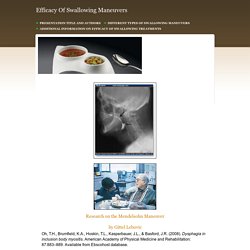
Dysphagia in inclusion body myositis. American Academy of Physical Medicine and Rehabilitation: 87:883–889. Available from Ebscohost database. Objective: To evaluate the clinical features, treatment strategies, and outcome of dysphagia in patients with inclusion body myositis. Mieux comprendre la néophobie alimentaire. Dysphagia Care for Individuals with Dementia. Dysphagia Care for Individuals with Dementia By: Rebecca Affoo MCISc., BHSc., Reg.

CASLPO, SLP (c); Ph.D. Candidate Introduction Dementia is a syndrome caused by a number of progressive disorders that affect memory, thinking, behavior, and the ability to perform activities of daily living (World Alzheimer Report, 2010). Alzheimer’s disease (AD) and other dementias currently affect more than 5 million Americans (Fargo and Bleiler 2014) and 747 thousand Canadians (Alzheimer Society of Canada, 2012), and the incidence is expected to exceed 7.1 million by 2025 (Fargo and Bleiler 2014). Individuals with mild dementia may experience early taste (Murphy 1999), smell (Nordin, Murphy et al. 1996), and swallowing dysfunction (Humbert, McLaren et al. 2010), which may result in decreased oral intake and weight loss. Détection et prise en charge des troubles de la déglutition chez le sujet âgé hospitalisé. Zenker's Diverticulum Causes, Symptoms, & Treatment. Zenker's Diverticulum - a sac or pouch in the back of the throat which causes difficulty swallowing by collecting and retaining food and saliva.
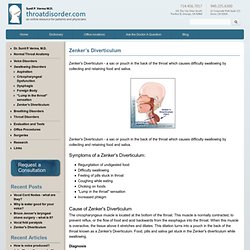
Symptoms of a Zenker's Diverticulum: Regurgitation of undigested foodDifficulty swallowingFeeling of pills stuck in throatCoughing while eatingChoking on foods"Lump in the throat" sensationIncreased phlegm Cause of Zenker's Diverticulum. Stepping Stones to Living Well with Dysphagia. National Foundation of Swallowing Disorders - American Board of Swallowing and Swallowing Disorders. Isokinetic (Dynamic) Shaker. Oral exercises to strengthen the swallowing function (entry page) The exercises and associated videos on the following webpage are only to be used under the explicit guidance of your physician or speech language pathologist (SLP).
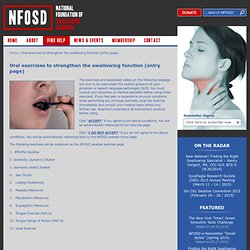
You must consult your physician or medical specialist before using these exercises. If you feel pain or experience unusual symptoms while performing any of these exercises, stop the exercise immediately and consult your medical team before any further use. Read and understand all instructions carefully before using.
Click “ACCEPT” if you agree to the above conditions. You will be automatically redirected to our exercise page. Click “I DO NOT ACCEPT” if you do not agree to the above conditions. The following exercises will be explained on the NFOSD swallow exercise page: Swallowing. A blog about all things swallowing. Swallowing & Swallowing Disorders - Curriculum Resources. MBSImP™©: Modified Barium Swallow Impairment Profile. The Modified Barium Swallow Study, while a clinically useful tool, remains a subjective test.

Evidence, rather than opinion, should guide clinical decision-making. The Modified Barium Swallow Impairment Profile, or MBSImP, is an evidence-based, standardization of the MBS study in adults. The MBSImP assesses 17 critical components of swallowing and provides an objective profile of the physiologic impairment affecting adult swallowing function. For the first time, the MBSImP provides the means for clinicians to communicate MBS study results in a standardized, evidence-based manner that is consistent, specific, and accurate. Welcome to www.steeleswallowinglab.ca. Best Practice in Videofluoroscopy by Dr. Catriona Steele, Carly Barbon and Ashwini Namasivayam. Best Practice in Videofluoroscopy Catriona M.
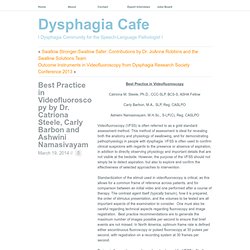
Steele, Ph.D., CCC-SLP, BCS-S, ASHA Fellow Carly Barbon, M.A., SLP, Reg. CASLPO Ashwini Namasivayam, M.H.Sc., S-LP(C), Reg. Consistency Guide. Finding what works best A dysphagia diet has two separate categories: liquids and foods.
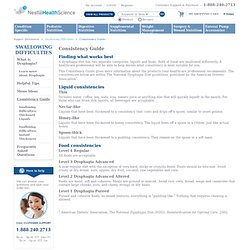
Both of these are swallowed differently. A healthcare professional will be able to help decide what consistency is most suitable for you. This Consistency Guide gives more information about the products your healthcare professional recommends. The consistencies below are within The National Dysphagia Diet guidelines, published by the American Dietetic Association1. Liquid consistencies. Welcome to Real Food Blends!, Meals for Tube-Fed People, Real Food for People on Feeding Tubes - Welcome to Real Food Blends! Choking Prevention Training Resources. Choking Prevention Resources OPWDD Preparation Guidelines for Food and Liquid Consistency Manual These are OPWDD guidelines written in standardized terminology for the six food consistencies and four liquid consistencies designed to meet individual needs.
In conjunction with these guidelines, individual assessments by appropriate clinicians are essential in developing the appropriate care plan to meet an individual’s specific dining needs. Questions ? - infodeglutition. Stroke rehabilitation. Long-term rehabilitation after stroke. Note from the National Guideline Clearinghouse (NGC): This guideline was developed by the National Clinical Guideline Centre (NCGC) on behalf of the National Institute for Health and Care Excellence (NICE). See the "Availability of Companion Documents" field for the full version of this guidance. Note: The wording used in the recommendations in this guideline (for example, words such as 'offer' and 'consider') denotes the certainty with which the recommendation is made (the strength of the recommendations).
See the end of the "Major Recommendations" field for further descriptions of the strength of recommendations. Aging and Swallowing: we all have to do it! By Karen Sheffler, MS, CCC-SLP, BCS-S A summary of a talk titled: “Managing Dysphagia in Aging Adults,” at the 2014 ASHA Healthcare & Business Institute by. My “name mnemonic” used for the Clinical Bedside Swallow Evaluation - Gray Matter Therapy. Today, Gray Matter Therapy is fortunate to have a guest post from Eric Blicker, CCC-SLP D. The clinical bedside swallow evaluation (CBSE) is a common procedure conducted in hospital and skilled nursing facility settings. As speech language pathologists (SLP), we are required to assist in making critical recommendations for patient care. The role of the SLP in the CBSE crosses over many components of patient care: respiratory, nutrition, digestion, hydration, phonation, and more. The SLP is also an educator as part of CBSE to patient, staff, and patient’s family.
It can seem overwhelming at times, to ensure that all of the components of the CBSE have been covered as the SLP is required to multi-task to capture the full clinical picture. POPS:P: Preparation: Have all supplies ready before you start. Vídeos Dysphagia Research Society no youtube.com. Menus intelligents pour Reflux gastro-oesophagien (RGO) Saveurs partagées. La gastronomie adaptée aux troubles de la déglutition. Ce recueil de recettes, réalisé de concert par deux cuisiniers présentant des troubles de la déglutition, est destiné aux personnes pour qui l'alimentation en consistance normale est devenue difficile ainsi qu'à leur entourage. Recettes pour cubes de glace au Resource ThickenUp Clear. Nous voulons attirer votre attention sur l’importance primordiale de l’hydratation, particulièrement lors de périodes de canicule. Une bonne hydratation lorsque les températures grimpent est un défi pour tous les âges.
Pour les personnes qui sont malades et/ou qui ont des problèmes de dysphagie, une bonne hydratation est un défi majeur. Une glace délicieusement fraîche peut faciliter agréablement l’hydratation. Lateral Medullary Syndrome (LMS) – Wallenberg Syndrome literature review. I want to share my literature review I did for fun when my son had just started at preschool, and I had a little more time on my hands! The inspiration was not only from my patients with LMS, but also from hearing James Coyle, PhD, CCC-SLP, BCS-S speak at an ASHA convention.
He was advocating for clinicians/dysphagia practitioners to do research. I then presented the information in a 2-hour lecture at the ASHA convention in San Diego in 2011. The literature review (LMS – Wallenberg Syndrome literature review and case studies) is extensive, at over 60 pages double spaced, but such a fascinating topic! I will add to this in the future as I’m sure there have been recent publications since I completed the writing several years ago. Swallowing (deglutition) from Anatomy & Physiology Online. Swallowing (deglutition) from Anatomy & Physiology Online. Swallowing (deglutition) from Anatomy & Physiology Online. Swallowing Strategies for Dysphagia. Swallowing Exercise Device for Swallowing Problems (Dysphagia) Understanding Dysphagia. Dysphagia - The Mechanically Altered Diet Made Easy. Swallowing Exercise Device - swallowingexercises.com. The New Method of Swallowing.
How To Eat When You Can't Swallow. Swallowing. Consistency Guide. DETECTION ET PRISE EN CHARGE DES TROUBLES DE LA DEGLUTITION CHEZ LE SUJET AGE HOSPITALISE — Santé-Limousin v.2. Digestive System Videos. Chewy Tubes Instructional Video. Lila's pre-feeding exercises (updated 5-13) Management of Speech Language and Swallowing Disorders in Huntington's Disease.
Shaker-like Swallowing Exercise Video With Research Summary. Dysphagia Therapy Exercises Video Open Jaw Exercise with Resistance. Webinar: Treatment for Dysphagia. Swallowing Reflex, Phases and Overview of Neural Control, Animation. The Process of Swallowing (Deglutition) Oral Mechanism Exam (Bedside Swallow Evaluation Part I) Food Trials (Bedside Swallow Evaluation Part II. The ABC's of videofluoroscopy of swallowing. Swallowing. Safe Swallow Training Video. Anatomie du pharynx et du larynx. Introduction to Larynx, Pharynx, and Airway Anatomy. Tongue-make your own tongue and vallecula-anatomy with your own hand model. CTAR (Chin Tuck Against Resistance) Yoon W.L., Khoo JKP, Liow SJR. Chin Tuck Against Resistance (CTAR): New Method for Enhancing Suprahyoid Muscle Activity Using a Shaker-Type Exercise. Dysphagia (2014) 29: 243-248.I was beyond excited to pick up my newest edition of the Dysphagia journal.
I've never said I wasn't a nerd. There was an article in the journal about chin tuck against resistance. I've always used what I call Modified Shaker exercises. Look at patients with dysphagia from Pharyngoesophageal Segment (PES) dysfunction, we look at strengthening the suprahyoid muscles. CTAR vs Shaker: Both have a component of isometric versus isokinetic. The isokinetic portion is 30 repetitions of up and down head movement 3 times.
This study used 40 healthy individuals (20 male, 20 female) 21-39 years of age. What the researchers found: CTAR: The Chin Tuck Against Resistance was less strenuous than the traditional Shaker, with increased sEMG values during isometric and isokinetic movement. Swallowing disorders. Free Water Protocol: For or Against. Difficulty Swallowing. La Petite Popote de Marjo. Sortie de livre : Saveurs partagées - La gastronomie adaptée aux troubles de la déglutition. Www.sgoc.fr/Brest 2010/communications/ateliers/SGOCd-glutition.pdf. Efficacy of Swallowing Maneuvers - Presentation Title and Authors. Www.txsha.org/_pdf/Convention/09Convention/Baringer Handouts/Barringer, Denise - Dysphagia Evaluation and Treatment_What You Need to Know.pdf. Dysphagia Therapy - Swallowing Exercises for Dysphagia Therapy. PINCES SUPPORT DE PAILLE. LozzanoGuatterie. Divers sites à ranger - APF.
Dysphagie - Éval & PEC. Eval Déglut - Nutilis. TbDg - Neuro. TbDg - Eval et PEC.